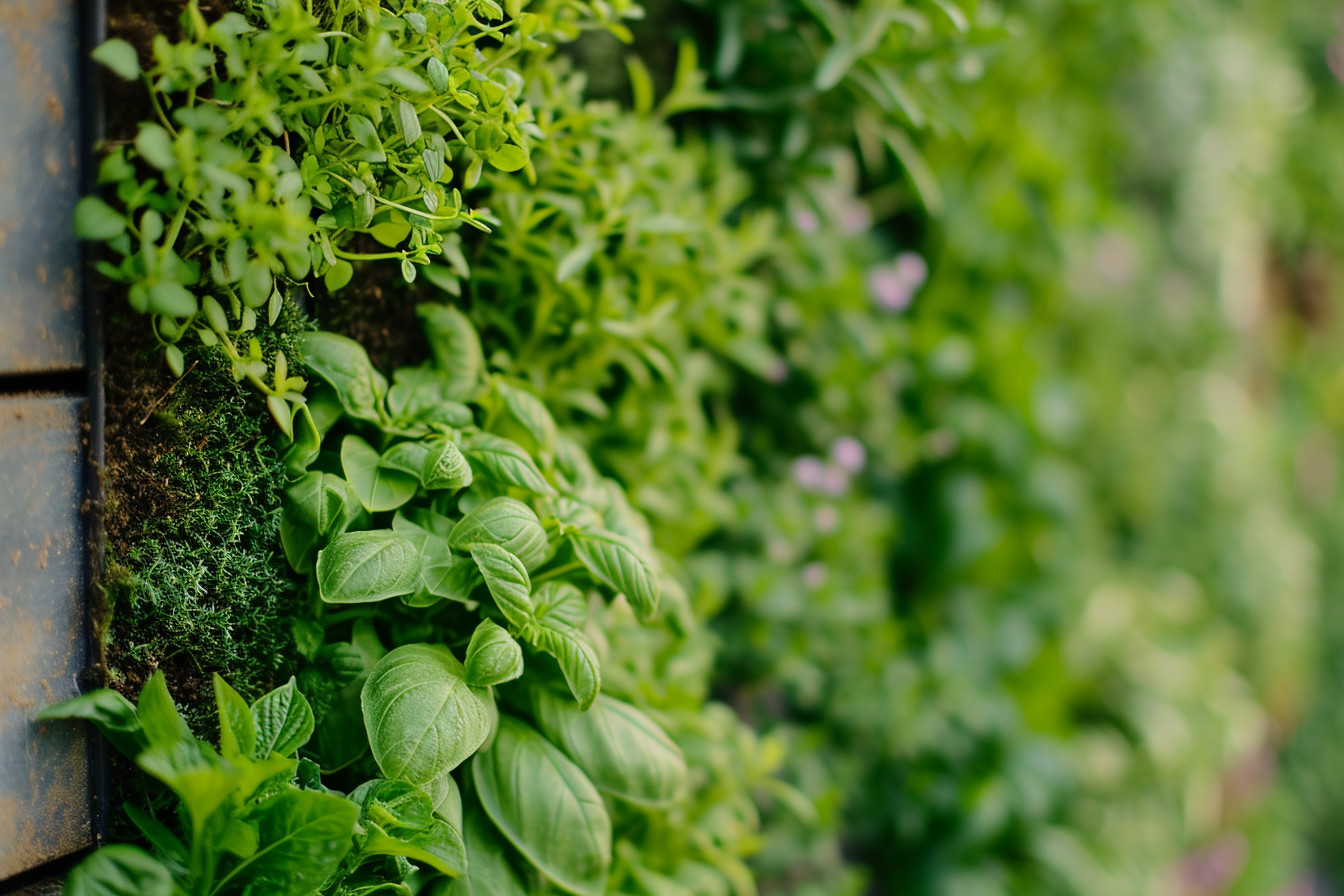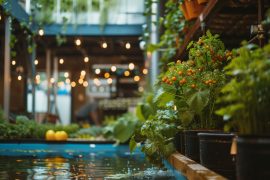As a gardening aficionado, I’ve always found peace in the rhythmic dance of planting and nurturing my garden. But beyond the tranquility, there’s a world of innovation that’s transforming how we grow our greens. Aquaponics and vertical gardening aren’t just buzzwords; they’re game-changers in the realm of sustainable agriculture.
I’m here to take you on an educational journey through the ins and outs of these cutting-edge techniques. Think of it as Gardening 101 with a futuristic twist. From the symbiotic marvels of aquaponics to the space-saving wonders of vertical gardens, I’ll break it all down in a way that’s both fun and easy to digest.
The Rise of Aquaponics
Sometimes, the most tranquil scenes in life are those steeped in growth and the lush, serene imagery of a garden. Aquaponics is in many ways the epitome of this image, blending the soothing qualities of water with the vibrant life of a garden. It’s a technique where I find not just food, but calm and a deep connection to nature’s cycles.
For those just tuning in, aquaponics is essentially a symbiotic system that marries aquaculture (raising fish) with hydroponics (soil-less plant growth). One of the coolest parts? The fish waste provides an organic nutrient source for the plants while the plants clean the water for the fish. It’s a closed-loop system that’s responsible, sustainable, and honestly, kinda mind-blowing.
But how did we get here, to this innovative fusion of fish and flora? Well, some say it’s a modern twist on the ancient practices of cultures that raised fish alongside rice paddies. Fast forward to now, and aquaponics is a cutting-edge answer to some of today’s food production challenges.
Aquaponics isn’t just about the food, though. Sure, I can rave about the fresh, organic produce or the practical benefits like water conservation (it uses up to 90% less water than traditional farming!). But what’s really incredible is how it’s changed my whole outlook on gardening. Gardening is no longer static; it’s a dynamic interplay where each lifeform helps sustain another.
My first foray into aquaponics was like mixing a science project with an art installation. Setting up my system was pretty straightforward:
- Fish tank: This is where the aquatic life lives and produces the waste that’ll feed my plants.
- Grow bed: This is where the plants will thrive, their roots dipping into nutrient-rich water.
- Pump and filter: These help circulate and clean the water, ensuring the system stays healthy for both fish and plants.
So, I set everything up, and my little ecosystem started buzzing with life. Every day, I’d see my leafy greens reach a bit higher while my fish swam contentedly below. And I’m not gonna lie, having a constant supply of herbs and veggies right in my place feels pretty awesome.
Understanding the Basics of Aquaponics
As I wander into my garden, I’m struck by the serene silence, except for the soft hum of water circulating through my aquaponic system. It’s a setup that’s not only supplying me with fresh greens but also offers a moment of tranquility each day.
Aquaponics can seem complicated, but I’ll break it down: it’s gardening powered by fish. Fish produce waste which, let’s face it, isn’t great for them, but it’s like gold for plants. This waste contains nitrogen, a nutrient that plants crave. In a nutshell, fish and plants are apartment-mates in aquaponics. They may not talk to each other, but they sure help each other out.
The setup starts with a tank for the fish. I remember picking out my first tank, feeling a mix of excitement and nervousness, like I was about to unravel the secrets of an ancient practice. Because, really, aquaponics is a modern spin on methods that date back to the Aztec Chinampas or those ingenious floating gardens.
Above the fish tank, I have what’s called a grow bed. It’s where the magic happens. The water from the fish tank gets pumped up and flows through the grow bed where my plants are chilling, quite literally, with their roots soaked in nutrient-rich water. They sip on what they need, and the cleaned water cycles back to the fish, creating a closed-loop system that’s a win-win for everyone.
It was a bit daunting at first, trying to strike that perfect balance. Too many fish and the water gets too murky, too few and the plants start giving you the side-eye because they’re starving. Here’s a tip I learnt: for every 100 liters (about 26 gallons) of water, you can safely house 1 kg (just over 2 pounds) of fish. That little tidbit made my life a lot easier.
| Water Volume (L) | Fish Weight (kg) |
|---|---|
| 100 | 1 |
| 200 | 2 |
| 300 | 3 |
The Role of Fish in Aquaponic Systems
As an avid gardener who’s dipped my toes into the serene waters of aquaponics, I’ve often been transfixed by the graceful dance of fish in my setup. Let me tell you, there’s something quite meditative about watching these aquatic creatures. They’re not just a pretty sight though; their role in aquaponics is as crucial as it is fascinating.
Fish are the powerhouses of an aquaponic system, setting everything in motion. It’s their waste that provides the essential nutrients plants crave. Without a good balance of fish, the system might falter, making these swimmers more than just ornamental features; they are key players.
I remember when I first started, I was advised to pick fish species based on several factors, such as my local climate and the kind of plants I wanted to grow. Different fish have varying tolerances and needs, much like plants do in traditional gardening. For instance, tilapia and catfish are hardy and can thrive in a wide range of conditions, which works great for newbies like I was at the time.
In my experience, keeping the tank clean and the water quality high is pivotal. Fish health directly impacts plant health. I’ve got a simple rule of thumb to check: if the fish are happy and active, it’s likely that my plants will be thriving too.
You might wonder how I manage the fish population – that’s through careful monitoring. You’ve got to strike a balance, and honestly, every aquaponics system is a bit different. It’s important to avoid overcrowding, as it can lead to issues with oxygen levels and waste concentration, which isn’t good for the fish or the plants – think of it as managing a delicate ecosystem where each lifeform supports the other.
Throughout the years, I’ve learned a thing or two about fish behavior and how their actions can signal the system’s overall health. Fish darting around quickly can sometimes mean there’s not enough oxygen in the water, while fish that feed less or seem lethargic might indicate a water quality issue. It’s this kind of close observation and rapid response that keeps everything ticking along nicely.
The Benefits of Aquaponics
In my time tinkering with garden spaces, I’ve found few things as rewarding as setting up an aquaponic system. There’s a sense of harmony achieved when you watch the fish glide serenely beneath the lush greenery of your plants. I often find myself lost in the tranquility of it all, reminding me just how deeply connected we are to the ebbs and flows of nature.
Beyond the peaceful vibes, there’s a wealth of knowledge ripe for the picking. Aquaponics isn’t a new concept; it’s a clever nod to the ancient practices of cultivating land near fertile water bodies. I believe in keeping things simple and approachable. So, here’s the deal: aquaponics is kind of like creating a mini ecosystem where fish and plants live in a mutually beneficial relationship. Think of it as nature’s own little circle of life – the fish provide nutrients for the plants, and in return, the plants filter the water for the fish. Neat, isn’t it?
Let’s dive into some specific benefits:
- Water Conservation: This system is a real champ at saving water. Traditional soil-based gardening gulps down gallons, but aquaponics recirculates the same water, which drastically cuts down usage.
- Less Labor Intensive: Say goodbye to hours of weeding, tilling, and soil testing. Aquaponic systems handle a lot of the grunt work, so it’s kinder on your back and your schedule.
- Organic Produce: Since it’s a closed system, there’s no need for synthetic fertilizers or pesticides. Plants get their nutrition straight from the fish waste – it’s all natural, baby.
- Year-Round Cultivation: I’ve found that with a little tweaking of the environment, you can grow fresh greens even when it’s snowing outside.
In my backyard, I have a small aquaponic setup that’s become my own lab for observing these principles in action. It started with a couple of goldfish and some lettuce seedlings, and quickly grew into something much more. Often, I’m asked about the technical side, like maintaining the right pH levels or the types of filters to use. I always stress the importance of starting simple. It’s not rocket science – there are plenty of beginner-friendly kits out there that have demystified the process.
Exploring Vertical Gardening
Stepping into a lush vertical garden feels like entering a living tapestry. As I weave through the serene space, I can’t help but feel a deep connection to the beauty around me. It’s not just about the plants reaching skyward; it’s about the harmonious interplay between nature and innovative design.
Vertical gardening isn’t new. Historically, it’s been traced back to the Hanging Gardens of Babylon, one of the Seven Wonders of the Ancient World. But don’t get overwhelmed by this grandeur. My journey into vertical gardening began with a simple vine clinging to a trellis and it’s been a learning curve bathed in tranquility ever since.
Why Vertical? Well, imagine you’ve only got a petite patio or a balcony. Does this mean your green thumb gets the cold shoulder? Absolutely not! Vertical gardens maximize limited spaces by expanding upwards instead of outwards. Aside from the aesthetics, they have heaps of benefits:
- They improve air quality
- Create a natural sound barrier
- Reduce your carbon footprint
- Offer a habitat for wildlife
I’ve learned quite a bit about different vertical gardening approaches, from trellises and tiered planters to living walls and towers. Each one offers unique advantages, and it’s amazing how easily these systems fit into both urban and suburban settings.
Let me guide you through the building blocks of vertical gardening:
- Structural Support: It all starts with a strong support system. Whether it’s a wall, a freestanding frame, or even upcycled materials, you want something that can handle the weight of plants, soil, and water.
- Plant Selection: Plants are the stars of the show. They need to thrive in your climate and, depending on your setup, withstand the vertical climb. Herbs, succulents, and certain veggies are my go-tos for starting out.
- Watering System: Vertical gardens need a consistent watering strategy. Some folks go for drip irrigation for its efficiency while others prefer hand-watering for its simplicity.
- Maintenance: Don’t forget about upkeep. Pruning, feeding, and pest management are all part of the package. Set a routine, and you’ll find it becomes a relaxing ritual.
My personal venture into vertical gardening transformed my own small balcony into a cascade of greenery. I remember installing my first set of simple shelves and filling them with potted ferns and flowers.
Vertical Gardening Techniques and Methods
When I think about vertical gardening, I’m often transported to a state of bliss, surrounded by creeping vines and lush greenery that climbs towards the sky. There’s something inherently peaceful about crafting a garden that not only spreads out but also reaches up, creating a living tapestry.
Trellising is one of the first techniques I explored in vertical gardening. It’s pretty straightforward – using a structure, usually made of wood or metal, to support the growth of plants upwards. But the tranquility these structures provide is anything but simple; they’re like sculptures that come to life with the plants that envelop them. Here’s how I like to set them up:
- Choose a sturdy trellis that can support the weight of mature plants.
- Position it where it’ll get ample sunlight and protection from harsh winds.
- Guide the young plants onto the trellis, and they’ll instinctively climb.
Another method I’ve enjoyed is the living wall concept. The idea, which started popping up in earnest in the early 2000s, turns a bland wall into a vivid statement. Picture a tapestry of succulents or an expanse of ferns that not only mesmerize but also improve the air quality around them.
Here’s a simplified breakdown for a DIY living wall:
- Install a frame with a built-in watering system against the wall.
- Fill with a growing medium, and then intertwine your preferred plants.
- Maintain by ensuring even moisture and providing regular trims.
Then there’s the world of hanging gardens. No, not the ancient wonder, but a modern take that’s perfect for balconies and patios with limited floor space. I like to use a variety of containers like macramé hangers or recycled materials, each giving a unique twist to the display.
Implementing hanging gardens usually involves:
- Selecting a mix of trailing and upright plants for visual interest.
- Making sure the containers have good drainage and are easy to water from below.
- Rotating regularly for balanced growth since they tend to lean towards the light.
What’s been a true revelation in my vertical gardening journey has been hydroponic towers. These are essentially self-contained vertical farming systems that I’ve found are not only space-efficient but incredibly productive. Herbs and leafy greens thrive in these systems, making urban gardening ventures seem like futuristic farms.
Maximizing Space with Vertical Gardens
Vertical gardens aren’t just a striking visual feature; they’re a testament to human ingenuity. Maximizing vertical spaces in gardening transforms the way I interact with my green friends, allowing me to work with nature in new dimensions – quite literally.
The first cousin to aquaponics in my book, vertical gardening, is about growing upwards instead of outwards. It’s all harmony and poetry, like vines reaching for the sky. I’ve seen spaces no bigger than a closet flourish into lush, verdant nooks that provide both nourishment for the body and tranquility for the soul.
Consider a trellis packed with vining plants like cucumbers or sweet peas. Picture it in your mind. Hear the bees buzzing around, feel the dappled sunlight on your skin. It’s a tiny piece of Eden in a concrete world. Living walls take this concept to a whole new level, creating a tapestry of green that’s not just beautiful, it’s downright therapeutic.
I remember my first hanging garden – a cascade of green, spilling from baskets suspended from the ceiling. The air felt fresher, laden with that earthy scent that only comes from happy plants. These hanging baskets aren’t just for show; they’re also productive members of my edible garden, bursting with herbs and strawberries.
When I introduced hydroponic towers, the game changed entirely. No soil, no problem – that’s my mantra here. These towers use water and nutrients to grow plants like lettuce and herbs in a small footprint. The simplicity of this system takes my breath away every time I harvest fresh greens within arm’s reach of my kitchen counter.
If you’re keen on giving vertical gardening a go, here’s my starter kit of recommendations:
- Begin with easy climbers: Go for peas, beans, or even some varieties of tomatoes.
- Pick the right structure: Choose a trellis, wall, or tower that fits your space and the plants you have in mind.
- Lighting: Make sure your vertical garden gets plenty of it, whether it’s natural or artificial.
- Watering prowess: Overhead watering can be a challenge; consider a drip irrigation system.
Combining Aquaponics and Vertical Gardening: A Match Made in Green Heaven
In my journey as a gardener, I’ve stumbled upon a serene yet powerful duo: aquaponics and vertical gardening. Together, they form an innovative synergy that’s both peaceful and productive. It’s like they were made for each other, creating a little piece of green heaven right in my backyard.
As I weave the tranquility of this setup into the fabric of my life, I can’t help but feel a profound connection to nature. Picture this—a harmony of fish gliding beneath a verdant tapestry of vertically suspended plants. It’s not just a method of gardening; it’s a living artwork that breathes fresh vitality into its surroundings.
The Basics Revisited
Before delving deep, let’s refresh the basics: Aquaponics merges aquaculture and hydroponics into an elegant loop of sustainability. Now, pair that with the concept of vertical gardening—growing plants upwards using trellises, walls, or towers—and you’ve got a flourishing column of life, defying gravity, and expectation.
This innovative mashup isn’t just for aesthetics—it’s a resourceful way to maximize space and resource use. With urban sprawl leaving little room for traditional gardens, vertical growth becomes not just clever but downright necessary. What’s more, by using vertical space, the plants gain better exposure to light, which is essential for their growth.
The Symbiotic Waltz
The synergy begins with the fish, whose waste offers a nutrient-rich buffet for the plants above. This isn’t your typical soil-fertilizer scenario. It’s an organic, living system that supplies everything the plants need to thrive. Each element of the system supports the others in a kind of symbiotic waltz that’s as peaceful as it is productive.
I remember setting up my first integrated system—a basic structure with climbing beans reaching for the sky as tilapia gently circled below. It wasn’t just the efficiency that struck me, but the stillness. The gentle sound of water and the rustling of leaves became my daily meditation soundtrack.
Final Thought
Stepping into the future of sustainable gardening, I’m thrilled by the possibilities that aquaponics and vertical gardening hold. It’s not just about growing plants or raising fish anymore; it’s about creating ecosystems where every element works in harmony. I’ve seen firsthand how these green spaces can transform concrete jungles into lush, productive havens. And let’s not forget the sheer joy of harvesting your own food from a system that’s as beautiful as it is functional. So whether you’re an urban dweller with limited space or a green thumb looking to innovate, embracing these gardening revolutions might just be the next best step. Happy gardening!










